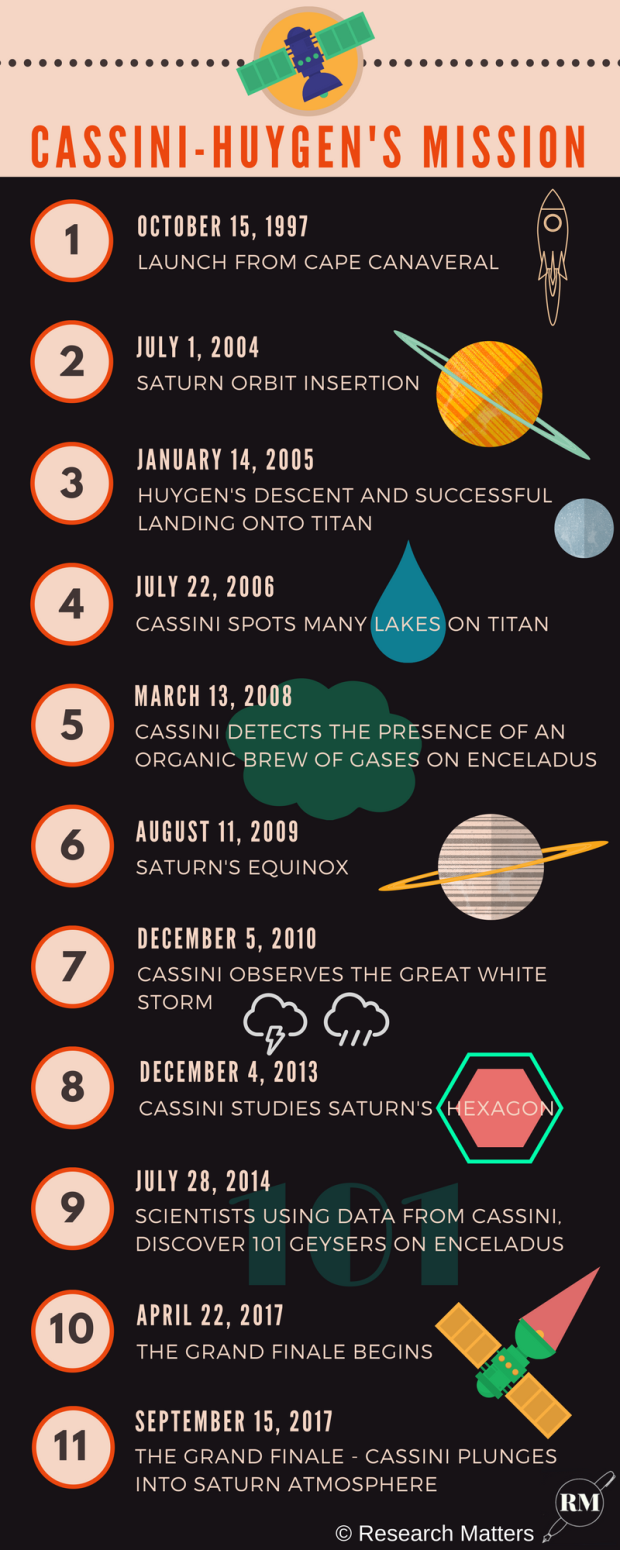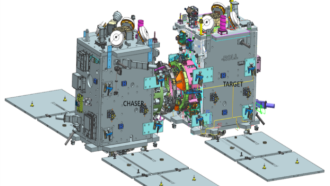
Infographic: Siddharth Kankaria / Research Matters
The sci-fi blockbuster ‘Oblivion’, featuring Tom Cruise, gave us a glimpse of life in 2077 on Titan, Saturn’s largest moon, after the Earth was devastated by an extra-terrestrial attack. But how far from reality is this? Going by Cassini-Huygens’ findings, perhaps it’s not too far!
Cassini-Huygens is the first unmanned spacecraft to orbit Saturn, a spectacular ringed planet in our Solar System. Launched on October 15, 1997, it set out to discover the planet and its satellites, up-close. In its twenty long years, the spacecraft has revealed many fascinating facts about Saturn, its rings, and its moons, including some clues about the possibility of life. However, all good things come to an end, and Cassini-Huygens is all set to draw a close to its eventful life in September 2017.
In the first seven years of its journey, the spacecraft hovered around Venus, flew past Mars, manoeuvred through the asteroid belt and slid past Jupiter, before finally entering Saturn’s orbit on July 1, 2004. Its end, equally special, will start on April 22, 2017, when it sails past Titan bidding a parting farewell, then criss-crossing Saturn's equator 22 times, and finally sinking into Saturn. According to NASA (USA’s National Aeronautics and Space Administration), the agency controlling the spacecraft, its thrusters have run out of fuel, forcing the inevitable death.
Cassini-Huygens - A Flagship Mission
Scientists at NASA, the European Space Agency and the Italian Space Agency, started the groundwork on Cassini-Huygens back in 1980s. Named after two Italian astronomers, Giovanni Cassini, who studied Saturn’s rings, and Christiaan Huygens, who discovered Titan, the spacecraft has two parts - the Cassini orbiter that orbits Saturn, and the Huygens probe that landed on Titan. Since Saturn is so far away from the Sun, it is infeasible to harness solar rays as a power source. Hence, Cassini-Huygens is powered with limited-period plutonium radioisotope electric generators that generate electricity like a nuclear power plant.
While Cassini was in orbit around Saturn, sandwiched between its two rings, it detached Huygens to descend on Titan on December 25, 2004. Huygens, after falling freely for 20 days, entered the history books as the first robotic probe to land on a satellite of another planet. It captured every detail of Titan's atmosphere and surface, and sent it to NASA’s Deep Space Network until its batteries drained up.
Understanding Saturn, its rings and moons
Saturn, with its majestic rings and enigmatic moons, is a jewel in our Solar System. It is the second largest planet after Jupiter, and is a gas giant made up mostly of hydrogen and helium. Its diameter is approximately 9 times that of the Earth, and it is 95 times more massive than the Earth. It is also the only planet in the Solar System that is less dense than water. Until recently, these were the only facts about Saturn that we knew.
Cassini-Huygens has tremendously increased our understanding of the Saturnian system. With numerous up-close observations, it has pointed out many earth-like features on Saturn. We now know that Saturn has numerous ‘jet streams’ that spew water vapour and heat into the atmosphere, of which the hexagonal jet stream in the north pole is one. Photographs by Cassini have revealed the magnificent symmetry of this stream and has shown this to be a long-lived phenomenon.
Cassini has captured glimpses of ‘lightnings’ and ‘hurricanes’ in the Saturnian atmosphere, and has studied the seasonal ‘Great White Storm’ - a once in 30 years phenomenon (1 Saturn year = 30 Earth years). It has also studied Saturn’s auroras, atmospheric composition, the swelling of its outer atmosphere, and the planet’s rate of rotation (1 Saturn day = 10.5 Earth hours), even correcting previous values by six minutes. By the end of its life, Cassini would have orbited Saturn 293 times, observing it for half a Saturn year.
The system of rings around Saturn is expansive and bright, and hence easily visible through a telescope. Named alphabetically based on when they were discovered, the rings consist of numerous icy rocks, ranging from the size of a grain of salt to the size of a mountain. With Cassini, scientists now have data about the size, temperature, composition and distribution of Saturn’s rings. It has studied the interactions between rings and moons, and has recorded instances of some moons stealing particles from a ring, or throwing particles into a ring.
Saturn’s equinox, when sunrays strike the rings on the edges, provides the perfect opportunity to capture intricate details and features of the rings. Cassini has used this occasion to observe previously unknown or poorly understood phenomena like the "spokes" in the rings, finger-like radial features that rotate along with the rings, like spokes in a wheel. Images captured during equinox also show that in places, Saturn’s rings are far less smooth than was thought.
Saturn has 62 known moons and numerous moonlets. Though early missions like Voyager and Pioneer provided a rough sketch of Saturn’s moons, it was poorly understood. Cassini has discovered seven new moons and revealed how each moon is unique and sharply different from the others. With high-resolution, close-up images of some of the moons - Phoebe, Enceladus, Iapetus, Rhea, Hyperion, Dione, and Titan, captured during fly-bys, we now know that most of these moons have cratered surfaces, some contain atmospheres and large amounts of ice, hinting at the possibility of life.
The most remarkable contribution of this spacecraft is the exploration of Titan. When Cassini flew by Titan, it saw beyond the orange haze of methane clouds, and revealed the presence of huge ‘lakes’ and ‘seas’ of liquid hydrocarbons (like methane and ethane). After Huygens landed on Titan, it revealed that Titan actually has a climate system like Earth, with a ‘water cycle’, where liquid hydrocarbons evaporate to form clouds, and later precipitate as rain. There was also evidence of an internal, liquid ocean beneath Titan’s surface, likely composed of water and ammonia.
Cassini also helped answer the reason behind Enceladus being the brightest object in the Solar System. It showed that beneath the icy crust of Enceladus, there may be an underground ocean, from which water vapour and ice particles frequently erupted. Subsequently, it detected water, carbon dioxide and various hydrocarbons, the presence of a unique chemistry and internal heat - the right composition to support life. This excited scientists looking for life, proclaiming Enceladus to be one of the ‘most likely places in the Solar System to host alien microbial life’. This discovery also gave a peek into how our Earth might have been before life originated.
A Grand Farewell
Cassini-Huygens has provided us with an intimate understanding of Saturn, its moons and its rings and has opened up a treasure trove of information. It has solved several intriguing mysteries and answered long standing questions about the Saturnian system. But, can life exist on Saturn? Cassinis’s vital clues have kept scientists pondering on that, while it begins its final journey to become one among Saturn’s specks of dust.






